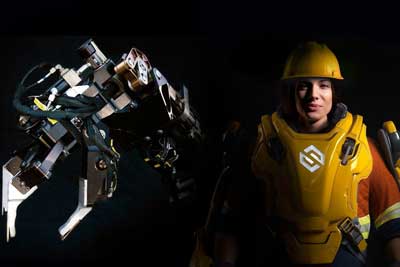| Oct 18, 2018 |
Researchers study Iron Man-like exoskeletons to improve worker productivity, safety, and well-being
|
|
(Nanowerk News) Over the next decade, American manufacturers are facing an industrial skills gap with projections of 2 million manufacturing jobs going unfilled due to a lack of qualified and skilled applicants. A large portion of the current manufacturing workforce is nearing retirement age and younger generations often lack the interest to learn the technical skills associated with jobs in manufacturing. Furthermore, occupational injuries cost U.S. companies more than $13 billion annually, with overexertion injuries accounting for the majority of injuries.
|
|
With a $3 million award from the National Science Foundation, Virginia Tech researchers will perform fundamental research to develop whole-body powered exoskeletons for augmenting human performance in industrial use and to understand the dramatic impacts they may have on the socio-technological landscape of jobs. The exoskeleton is a wearable device that can augment the strength and endurance of the wearer by supporting body joints and providing assistive movements and joint torques.
|
|
Divya Srinivasan, assistant professor in the Grado Department of Industrial and Systems Engineering in the College of Engineering, is leading the grant, “Whole-body Exoskeletons for Advanced Vocational Enhancement.” Awarded by NSF’s Future of Work at the Human Technology Frontier program, this project aims to develop and evaluate new controls and human-machine interfaces for powered exoskeletons, for increasing industrial worker productivity and lowering injury risks, while also preserving human skill for operating in dynamic, unstructured environments.
|
|
The research will be conducted in partnership with Sarcos Robotics, a company that has 20 years of experience developing powered exoskeletons with funding from DARPA and the Department of Defense.
|
 |
| Sarcos Guardian XO Exoskeleton. (Image: Sarcos)
|
|
“Imagine waking up and being capable of doing heavy physical jobs without pain or injuries,” said Srinivasan. “Productivity would be boosted if people are healthier and safer. Workers currently in those positions would be able to do the job with less physical effort and in a safer way, develop new technological skills, and possibly get paid better. We are hopeful that younger generations will not look down upon heavy industrial jobs as a result.”
|
|
The team plans to design new control and interaction interfaces to make the exoskeleton use natural and intuitive, thus minimizing learning time and enabling adaptation to dynamic environments. They will design an augmented reality-based interface that the user can wear and use to interact with the exoskeleton. Assistance from the exoskeleton will be adapted according to user and context. This will allow for augmentation of a user's perception and cognition when using physical capacity augmentation systems.
|
|
"One of the concerns we have with the technology is that it might be so physically focused in terms of decreasing physical demands that it may drive up the cognitive demands,” said Srinivasan.
|
|
Hence, evaluation and iterative redesign of all technologies will incorporate tests using a range of diverse workers, including those with reduced physical abilities and mild cognitive impairments, to ensure that the overall design will be effective and inclusive across the workforce.
|
|
The team includes Maury A. Nussbaum, professor, and Nathan Lau, assistant professor, both from industrial and systems engineering; Alexander Leonessa, professor in mechanical engineering; and Suqin Ge, associate professor of economics in the College of Science.
|
|
The interdisciplinary team also includes collaborators from the College of Engineering, the School of Visual Arts, University of Virginia, and University of California Santa Barbara.
|
|
While the engineering team will work to advance knowledge and state-of-the-art in exoskeleton control, human-robot cooperation, human factors, and augmented reality systems, Ge’s team will build empirical models of the effects of augmentation technology on worker productivity and well-being, industry profits, and the labor market in general.
|
|
The results will help both exoskeleton manufacturers and industry leaders determine appropriate job types, tasks, related costs, and markets for exoskeleton suit investments.
|

